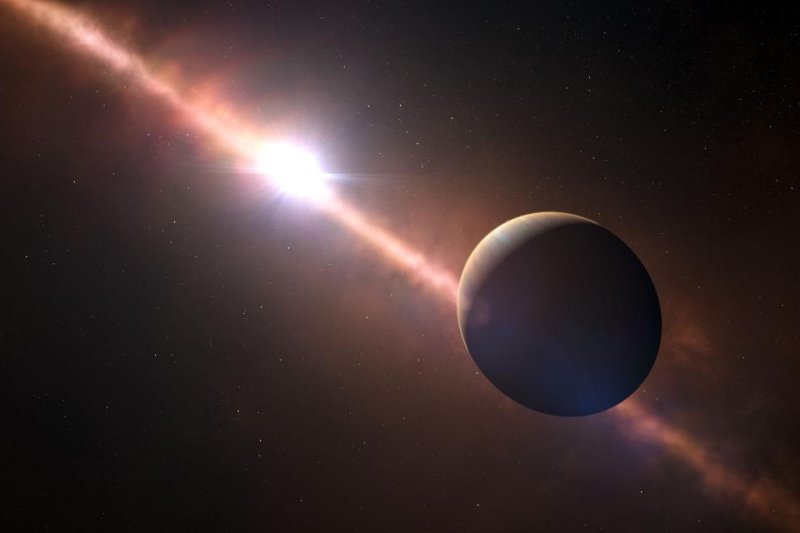An artistic impression of the exoplanet Beta Pictoris b and its young host star. Photo by ESO/L. Calçada/N. Risinger
June 29 (UPI) -- For the first time, astronomers have measured the spin-orbit alignment of a faraway super-Jupiter exoplanet, located 63 light-years from the Earth in the Pictor constellation.
The super-Jupiter exoplanet, Beta Pictoris b, has a mass 11 times that of Jupiter and enjoys an orbit around its host star similar to the trajectory Jupiter takes around our own sun.
The detailed observations of Beta Pictoris b -- shared Monday in the Astrophysical Journal Letters -- could help scientists better understand the formation and evolution of planetary systems.
"The degree to that a star and a planetary orbit are aligned with each other tells us a lot about how a planet formed and whether multiple planets in the system interacted dynamically after their formation," lead study author Stefan Kraus said in a news release.
During the 18th century, scientists Immanuel Kant and Pierre-Simon Laplace noticed that the orbital planes of the solar system's planets were largely aligned. They estimated that Earth and its planetary neighbors formed from a rotating and flattened protoplanetary disc.
"It was a major surprise when it was found that more than a third of all close-in exoplanets orbit their host star on orbits that are misaligned with respect to the stellar equator," said Kraus, professor of astronomy and physics at the University of Exeter in Britain.
"A few exoplanets were even found to orbit in the opposite direction than the rotation direction of the star," Kraus said. "These observations challenge the perception of planet formation as a neat and well-ordered process taking place in a geometrically thin and co-planar disc."
Using the GRAVITY instrument on the Very Large Telescope in Chile, scientists measured the minuscule spatial displacement caused by the stellar rotation of Beta Pictoris. The data revealed an alignment between the star's rotational axis and the orbital axis of the planet Beta Pictoris b and its surrounding debris disk.
"Gas absorption in the stellar atmosphere causes a tiny spatial displacement in spectral lines that can be used to determine the orientation of the stellar rotation axis," said study co-author Jean-Baptiste LeBouquin, an astronomer at the University of Grenoble in France. "The challenge is that this spatial displacement is extremely small: about 1/100th of the apparent diameter of the star, or the equivalent to the size of a human footstep on the moon as seen from Earth."
The latest findings showed the Beta Pictoris system is just as aligned as our own solar system, but authors of the new study suggest a wider sample size is needed to confirm how common spin orbit alignment is throughout the cosmos.
"A dedicated high-spectral resolution instrument at VLTI could measure the spin-orbit alignment for hundreds of planets, including those on long-period orbits," said Kraus. "This will help us to answer the question what dynamical processes shape the architecture of planetary systems."















